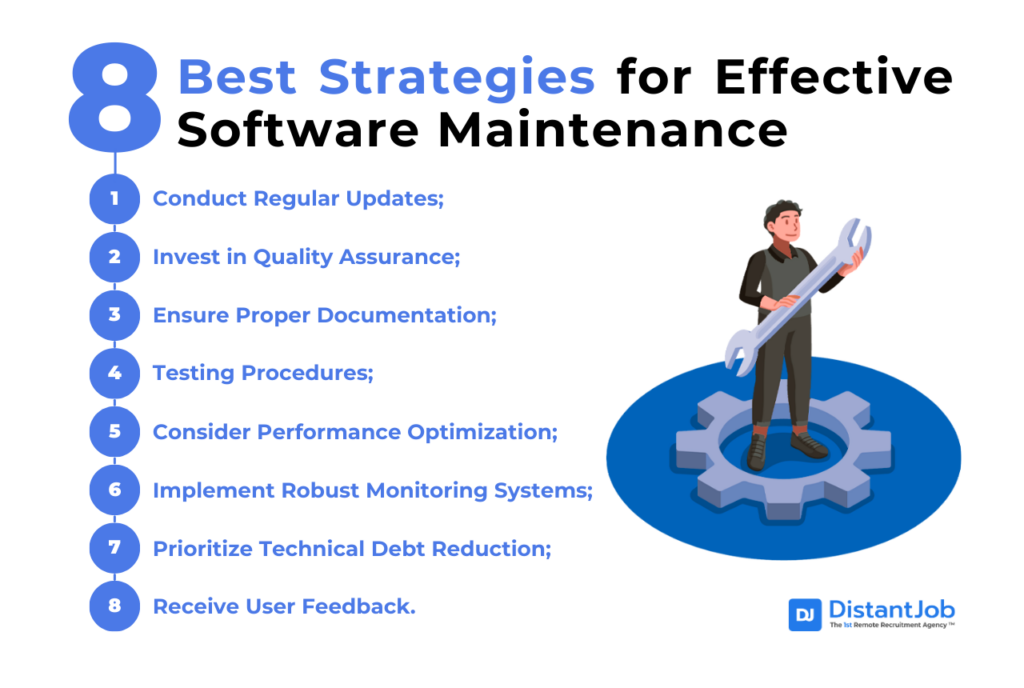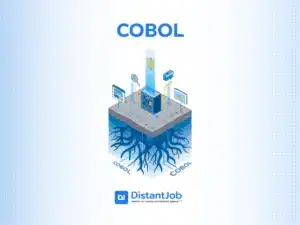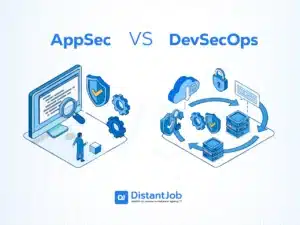In software development, the key stages of planning are usually design, coding, testing, and deployment. However, the software development cycle doesn’t end after the deployment phase. Much of the work begins at the launch, but there’s an important phase after deployment—the software maintenance stage, also known as the operational stage in DevOps.
Once you deploy your software, you must regularly refresh it to ensure it runs smoothly and the systems are reliable.
Software maintenance refers to the ongoing process of modifying, updating, and optimizing software after its deployment. This includes fixing bugs, improving performance, adapting to new environments, and enhancing features based on user needs.
The software maintenance process is an essential part of the software development life cycle (SDLC) that seeks to enhance user experience, reduce downtime, and modify the system for future changes.
Let’s go over software maintenance in detail.
What is Software Maintenance?
Software maintenance refers to the process of modifying and updating a software system after it has been delivered to the customer. Maintenance is done after the software is released to correct bugs and boost performance.
Key Components:
- Bug fixes and error correction – These are the core of solving issues during the software development life cycle.
- Feature updates and enhancements – It’s when you add new functionalities to meet user needs.
- Performance optimization – This key component ensures improved software speed, efficiency, and resource utilization. There is always room for improvement.
- Security patches – They involve fixing vulnerabilities, maintaining system security, and ensuring compliance.
- Compatibility updates – Compatibility builds integration with new hardware, legacy systems, operating systems, or third-party integrations
However, software maintenance can be very costly. According to industry studies, software maintenance might account for 60 to 90% of total software lifecycle costs, especially in enterprise applications with long lifespans. Continuous maintenance is key for both performance enhancements and efficient cost management.
What are the Four Main Types of Software Maintenance
There are many software maintenance approaches to choose from. For instance, you can identify and fix known issues on the spot. This is called corrective maintenance. There are other approaches, such as preventive maintenance, which addresses potential problems before they happen; perfective maintenance, which creates patches based on users’ needs; and security maintenance, which ensures data security and compliance, among others.
1. Corrective Software Maintenance
As the name “corrective” suggests, this type of maintenance seeks to identify, analyze, and rectify issues that could’ve surfaced during the software’s use.
For example, users might report a bug or an error in a piece of software, or when something significant goes wrong. Some of the reported issues could majorly impact the software functionality and must be addressed as quickly as possible.
The best part of the corrective software maintenance process is that you don’t need to wait until users report an issue with the software product. You can always schedule corrective maintenance shifts to spot and address any faults before users discover error messages.
2. Preventive Software Maintenance
Preventive software maintenance involves addressing any small issues with the software that could blow up into something big. The process aims to reduce the risk associated with operating software by making it stable, understandable, and maintainable.
It’s the role of your software development team to carry out a maintenance process that addresses the faults within software applications before they impact various parts of the software architecture, such as the logic and code.
Make necessary upgrades or adaptations so that the software can continue to work as desired for a long time. For example, you may review the software and decide to optimize the code or update documentation, which, in turn, may prevent software deterioration throughout its adaptation and change.
3. Perfective Software Maintenance
Perfective software maintenance comes into play once the software is released and open for public use. It’s a maintenance approach often considered when new issues and ideas that could potentially make the software the best tool available arise.
This type of maintenance aims to modify software, including user suggestions or any feature that could be useful in the long run. It could also involve removing features that are not effective in the software. The process enhances user experience and keeps software up to date with the changing market and user dynamics.
4. Adaptive Software Maintenance
Adaptive software maintenance is a maintenance protocol that ensures the software is up-to-date and compatible with new technologies, security threats, operational processes, and many more. It’s a necessary process, especially when the software environment changes.
For example, if you’re running an e-commerce business and want to update payments on the site, then you’ll need to conduct an adaptive maintenance exercise to change the payment processors.
You can also carry out the exercise to ensure that a product interfaces with new software dependencies, hardware, or operating systems.
| Type | Goal | Trigger | Example |
| Corrective | Fix existing bugs/errors | Bug report or crash | Fixing a login error |
| Preventive | Prevent future issues | Internal code review | Refactoring legacy code |
| Perfective | Enhance usability or features | User feedback | Adding dark mode UI |
| Adaptive | Ensure compatibility with changes | Tech/environment changes | Updating for iOS 18 compatibility |
Software Maintenance Process
Despite different types and approaches, software maintenance has a clearly identifiable process that can be defined step-by-step. Here are the steps involved when we need to change or fix software:
1. Identify & Track
This is about figuring out what needs to be changed or fixed. For example, a user asking for something new, or the system itself reporting an error. We also decide what kind of maintenance it is (e.g., a bug fix, an improvement).
2. Analyze
Next, we study the proposed change. We look at how it might affect the system, especially regarding safety and security. If the impact is big, we might look for different ways to do it. We then write down exactly what needs to be done and estimate costs.
3. Design
In this phase, we plan how to make the changes. It involves designing any new parts of the software or modifying existing parts. We also create tests to make sure the changes are proper to the project.
4. Implement
Implementation is where we write the code for the changes, following the design. Each programmer also tests their own part of the code in parallel.
5. System Testing
After coding, we test how the new parts work together and how they work with the existing system. We also do a full system test to ensure everything still functions properly.
6. Acceptance Testing
Once our internal tests are done, we let users test the system to make sure it meets their needs. If they find any issues, we address them or plan to fix them later.
7. Delivery
After getting user approval, the updated software is released to everyone, either as a small update or a new installation. We do a final check once it’s live. If needed, we also provide training and user manuals.
8. Maintenance Management
This involves keeping track of all the changes made to the software. We use tools to manage different versions and updates.
Which Software Maintenance approaches are there?
However, when it comes to software maintenance, there is no one-size-fits-all approach. Instead, every software product undergoes many types of maintenance, each serving a specific purpose to address different needs throughout the software’s lifecycle.
For instance, you can implement a self-healing, AI-driven maintenance program to detect and instantly address issues. You can also opt for performing security patches to tackle vulnerabilities. And if your company has an infrastructure in the cloud, it also requires its own kind of software maintenance.
1. NoOps: AI-driven Maintenance
NoOps (No Operations) is a model where AI and automation replace human intervention in system maintenance. Its goal is a fully autonomous infrastructure management.
AI-driven systems automatically detect anomalies and solve issues without human intervention to minimize downtime. It can be done both proactively and correctively.
For example, Amazon uses continuous monitoring and AI-based anomaly detection to ensure 99.999% uptime across AWS services.
Dynatrace (Pro-Active and Corrective Maintenance)
It uses Davis AI for anomaly detection in real-time, root cause analysis, and automatic performance optimization. It works great for distributed, complex environments.
Datadog (Pro-Active Maintenance)
It offers monitoring resources with machine learning functions for anomaly detection, metrics, and logs. It can also predict performance metrics and resource usage.
Ansible Automation Platform (Corrective Maintenance)
Ansible can be used for self-healing. It integrates alerts and insights from AI tools (such as Dynatrace or Python scripts) so that Ansible automatically runs playbooks to resolve issues (restarting a service, scaling a pod, or applying a patch).
2. Security Maintenance
Security maintenance is the ongoing process of keeping software and applications safe. This maintenance approach isn’t an afterthought; instead, it’s built in parallel with development and deployment processes.
Key aspects of software security maintenance include:
- Vulnerability Monitoring and Management: Continuously monitoring for new vulnerabilities, assessing their potential impact, and prioritizing them for mitigation.
- Security Training: Constantly training the company’s employees on cybersecurity best practices. According to Verizon, 60% of security breaches involve the human element. This might extend to the SDLC if the company is not careful.
- Patch Management: Regularly applying security updates (patches) released by software vendors to address known vulnerabilities.
- Secure Configuration: Ensuring software is configured securely, disabling unnecessary features, and using secure protocols for data transmission.
- Regular Security Audits and Assessments: Performing periodic security assessments, such as penetration testing, to identify potential weaknesses.
- Incident Response: Having a plan in place to respond to security incidents and breaches.
- Zero Trust: A security model that operates on the principle of “never trust, always verify”. It requires continuous verification and authorization of all access attempts, from login to downloads.
- Staying Updated: Keeping up with the latest security best practices and threats.
3. Cloud and Container Maintenance
Even if your application, server, or database is on the cloud or in a Docker container, it requires maintenance. Cloud and container maintenance involves managing and updating the infrastructure and applications within a cloud environment, specifically focusing on containerized workloads.
This approach ensures the security, performance, and availability of both the cloud platform and the containers running on it. Common tasks for cloud and container maintenance include patching, monitoring, scaling, and orchestrating container deployments.
Keep in mind that cloud infrastructure maintenance includes maintaining the underlying cloud resources like virtual machines, networks, and storage. It involves tasks like applying security patches, managing access controls, and optimizing resource utilization (for cost optimization).
For containers, the focus is on the lifecycle of containers, including deployment, scaling, and updates. Container orchestration tools like Kubernetes, Docker, or Jenkins play a crucial role in automating these processes.
Software Re-engineering
Software re-engineering is a specialized activity within software maintenance, a specific subtype of perfective or adaptive maintenance, often large-scale. It addresses significant changes and modernizations to existing systems, overcomes technical debt, leverages new technologies, or improves fundamental aspects of the software.
In short, engineers examine and modify a system to reconstitute it in a new form. The ultimate goal is improving a system’s maintainability, functionality, performance, or adapting it to new technologies. It’s more than typical small bug fixes or minor feature enhancements: it’s a radical transformation.
As you can see, re-engineering isn’t just about changing programming languages; it encompasses a wide range of transformations to modernize and improve existing software. Here are some modern examples of software re-engineering, categorized by common motivations:
1. Migrating from Monolithic to Microservices Architecture
Monolithic applications can become difficult to maintain, scale, and deploy as they grow globally. Breaking them into smaller, independent microservices allows for greater agility, scalability, and resilience.
Examples:
Netflix: It transitioned from a monolithic DVD rental platform to a highly distributed, microservices-based streaming service. This change allowed them to scale rapidly and innovate quickly, with different teams managing distinct services.
E-commerce Platforms: Many large e-commerce sites (like those built on older platforms) re-engineer their backend to use microservices for product catalogs, order processing, user authentication, and payment gateways. Now they can handle high traffic, roll out new features independently, and ensure specific parts of the system don’t bring down the whole.
Financial Institutions: Banks and other financial organizations often have old legacy monoliths. Transforming them into microservices modernizes specific functionalities (as loan approvals or fraud detection) without a complete system overhaul, improving speed and compliance.
2. Cloud Migration and Cloud-Native Re-engineering
Moving from on-premises infrastructure to cloud platforms (as AWS, Azure, and Google Cloud) offers benefits like scalability, cost efficiency (pay-as-you-go), improved security, and global accessibility. “Cloud-native” re-engineering designs applications specifically to leverage cloud services.
Examples:
Enterprise Applications: Enterprise resource planning (ERP), customer relationship management (CRM), and supply chain management (SCM) systems might run on cloud platforms. They can either “lift and shift” (rehosting) or carry out deeper refactoring with the help of experienced ERP developers who leverage cloud‑specific services such as managed databases, serverless functions, or containerisation (Docker & Kubernetes).
Data Analytics Platforms: Legacy data warehouses and analytics tools are often re-engineered and moved to cloud-based data lakes, real-time streaming services, and scalable computing platforms for Big Data processing.
SaaS Providers: Software-as-a-Service (SaaS) companies re-engineer their applications to be truly cloud-native, allowing them to offer multi-tenancy, elastic scaling, and continuous deployment. They often restructure their monoliths into microservices as well.
3. Language/Framework Modernization and Refactoring
Old programming languages or deprecated frameworks can lead to higher maintenance costs, security vulnerabilities, scarce talent hiring, and zero integration with modern technologies. Refactoring improves the internal structure of the code without changing its external behavior.
Examples:
PayPal: Modernized its systems by switching to the Go programming language to improve efficiency, scalability, and reduce time to market for new applications.
Legacy Desktop Applications to Web/Mobile: Many older desktop applications (e.g., built with Visual Basic, Delphi, or older .NET Framework versions) are re-engineered into web-based or mobile-first applications using modern frameworks like React, Angular, Vue.js, or .NET Core. This provides better accessibility, wider reach, and a more modern user experience.
COBOL Systems Modernization: While less common for new development, many critical systems in banking and government still rely on COBOL. Re-engineering efforts often involve encapsulating COBOL logic, integrating it with newer systems via APIs, or even selectively rewriting parts of it in more modern languages.
8 Best Strategies for Effective Software Maintenance
To ensure effective software maintenance for all your projects and software development process, start by implementing regular software monitoring to guarantee it is up to date and fully functional.
You should follow up with regular upgrades to ensure that the systems have the latest patches and features for a more secure and stable software.
Here is a more detailed look at the best strategies for effective software maintenance:

1. Conduct Regular Updates
The reason your software is prone to errors and systemic failures is that to the overlooked vulnerabilities that make it outdated. Software that’s not regularly maintained and updated has weaknesses that could lead to data breaches and slowed systems.
If you want to keep your software in its optimal state, consider updating it regularly to stay current with software versions. Updates provide improved functionality and the latest patches that address existing vulnerabilities, like bugs and crashes.
2. Invest in Quality Assurance
As a standard protocol, your software must pass through various testing phases before going live. Quality Assurance helps to catch problems early, reducing the need for emergency fixes after deployment. Always invest in proper end-to-end and UI testing for effective software maintenance to ensure usability and integration. Follow up with a concurrent Quality Assurance exercise from planning to the testing phases to further reduce the need for post-production software maintenance.
3. Ensure Proper Documentation
Detailed documentation plays a significant role in software maintenance by providing a roadmap for all maintenance activities. It works for complex software environments involving distributed teams working on one project.
Developers working on the software maintenance project can greatly enhance the quality and usefulness of the software products by following the best practices documented. This makes it easier for future developers to maintain code and learn from the past developers’ mistakes.
This documentation advice also applies to version control systems (Git) to manage source code and track changes. When your devs commit to a change, make sure they write a message about it in their “git commits”. This way, your team can easily track back and revert to previous versions if needed and maintain a consistent development environment.
4. Testing Procedures
Testing procedures are vital to ensure their continued relevance and effectiveness in any software maintenance exercise. It involves regularly reviewing new software updates and changes to ascertain whether they introduce any issues. Effective software maintenance requires you to establish rigorous testing procedures that can help maintain the integrity and functionality of your software. Set up testing procedures, such as unit or integration tests, that reveal whether your software performs as expected.
5. Consider Performance Optimization
Performance optimization in software maintenance refers to the process of refining the software to keep it as effective and efficient as possible. Optimizations are crucial preventative measures that help you resolve and address issues before they become critical.
Performance optimization practices in software maintenance ensure your software performs at its best over its minimum lifetime. This can take any form or measure, such as optimizing code or reworking the software architectural design to align with evolving technologies.
6. Implement Robust Monitoring Systems
Use tools like Application Performance Monitoring (APM) to detect anomalies, performance bottlenecks, security threats, and operational inefficiencies in real-time. Set up alerts for critical thresholds and analyze logs and metrics for patterns.
Your team can also utilize bug-tracking systems (e.g., Jira, Bugzilla) to prioritize and resolve issues quickly. Categorize bugs by severity and priority, and ensure clear communication between teams about them. Instead of waiting for a glitch to be reported by the end user, it’s vital to keep a log tracking of all potential issues.
7. Prioritize Technical Debt Reduction
Address technical debt (shortcuts or quick fixes) by writing clean, efficient code and adhering to coding standards. Regular code reviews and refactoring are key.
This is particularly necessary when your company uses LLMs in the development stage as well. You never know if the AI is stockpiling its technical debt in your application until it’s too late.
8. Receive User Feedback
Actively encourage users to report bugs, suggest improvements, and share their experiences. User insights are invaluable for identifying issues and making informed decisions about updates and enhancements.
Make sure your team is well-informed about how the user experiences their software.
How much do these Software Maintenance Types cost?
The Software Maintenance costs can vary from project to project, but these types can have a similar impact on total cost development. According to Vention, the industry spends only 5% of the budget on Preventive Maintenance, while most of the budget goes to Adaptive Maintenance (50%). Here is the breakdown:
| Software Maintenance Type | Budget Allocation on Maintenance |
| Adaptive | 50% |
| Predictive | 25% |
| Corrective | 20% |
| Preventive | 5% |
Software Maintenance Cost Estimation
Software maintenance costs also vary according to the software category. Here we are sharing Vention’s study for Simple, Complex, and Enterprise software. The monthly costs are based on the average monthly hours * the software maintenance engineer’s hourly rate.
| Simple | |||
| Software categories | Average monthly users | Engineering team size (time & materials) | Estimated monthly maintenance cost, USD |
| Email & communication platforms | 1,000 | 0.5 | 6,000 |
| Native mobile apps of medium complexity | 10,000 | 1 | 11,000 |
| Office productivity software | 200 | 0.5 | 6,000 |
| Web applications with standard functionality | 100,000 | 1 | 11,000 |
| Large | |||
| Software categories | Average monthly users | Engineering team size (time & materials) | Estimated monthly maintenance cost, USD |
| Project management software | 500,000 | 2 | 25,000 |
| Customer relationship management | 600 | 2 | 25,000 |
| Content management systems | 300,000 | 2 | 25,000 |
| HR management systems | 3,000 | 2 | 25,000 |
| Infrastructure and platform services | 200,000 | 2 | 25,000 |
| Enterprise | |||
| Software categories | Average monthly users | Engineering team size (time & materials) | Estimated monthly maintenance cost, USD |
| Financial management and accounting software | 2,000,000 | 4 | 60,000 |
| Inventory and supply chain management systems | 200,000 | 4 | 60,000 |
| Enterprise resource planning systems | 200,000 | 4 | 60,000 |
| Business intelligence and analytics platforms | 2,000,000 | 4 | 60,000 |
| Custom-built software and system integrations | 2,000,000 | 4 | 60,000 |
Conclusion
Software maintenance plays a crucial role in optimizing software systems and keeping them efficient throughout the SDLC. Maintenance processes, such as preventive, perfective, adaptive, and corrective, are key practices for ongoing software improvement.
These maintenance practices are vital in software engineering as they improve software systems to make them more efficient. They also ensure increased productivity and could help you cut on revenue loss occasioned by costly workflow interruptions due to inefficient systems.
Maintenance success depends on having a well-trained, proactive team. Don’t underestimate the need for skilled developers to implement ongoing improvements. If your company needs a proper security team, here is my advice for you.
Hire pre-vetted passive candidates with DistantJob. Our specialty is to find the best remote developers in the world: cultural fit, hard, and soft skills included. You don’t need to pay expensive expert software maintenance engineers, while you can hire the same expertise at half the cost. Contact us to know more!





